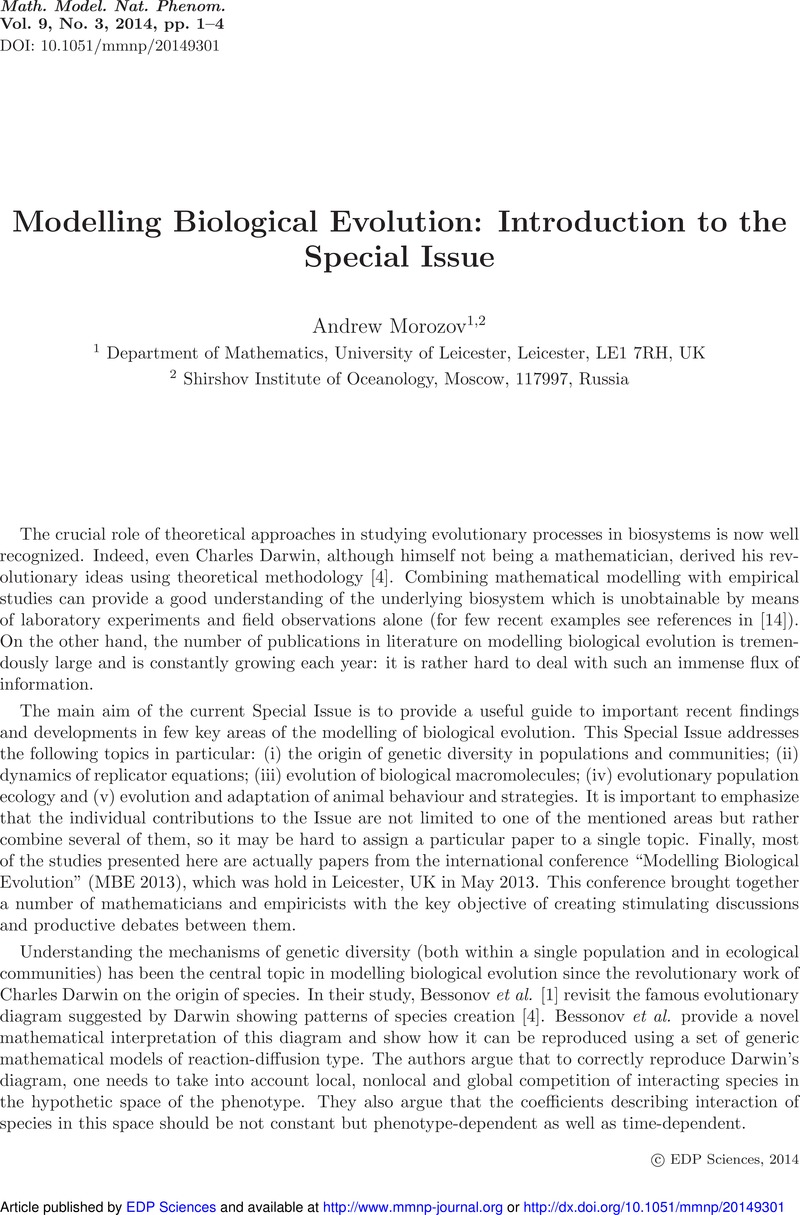No CrossRef data available.
Article contents
Modelling Biological Evolution: Introduction to the Special Issue
Published online by Cambridge University Press: 28 May 2014
Abstract
An abstract is not available for this content so a preview has been provided. As you have access to this content, a full PDF is available via the ‘Save PDF’ action button.

- Type
- Editorial
- Information
- Mathematical Modelling of Natural Phenomena , Volume 9 , Issue 3: Biological evolution , 2014 , pp. 1 - 4
- Copyright
- © EDP Sciences, 2014
References
N. Bessonov, N. Reinberg, V. Volpert. Mathematics of Darwin’s diagram. Math. Mod. Nat. Phen., (2009), 5–25.
A. S. Bratus, V.P. Posvyanskii, A. S. Novozhilov. Replicator equations and space. Math. Mod. Nat. Phen., (2014), 47–67.
M. Broom, J. Rychtár˘, D. Sykes. Kleptoparasitic interactions under asymmetric resource valuation. Math. Mod. Nat. Phen., (2014), 138–147.
C. Darwin. The origin of species by means of natural selection. Barnes and Noble Books, New York, 2004. Publication prepared on the basis of the first edition appeared in 1859.
Eigen, M., McCascill, J., Schuster, P.. The Molecular Quasi-Species. Adv. Chem. Phys., 75 (1989), 149–263. Google Scholar
J. Z. Farkas, A. Yu. Morozov. Modelling effects of rapid evolution on persistence and stability in structured predator-prey systems. Math. Mod. Nat. Phen., (2014), 26–46.
J. Hofbauer, K. Sigmund. Evolutionary Games and Population Dynamics. Cambridge University Press, 1998.
Kokko, H., Heubel, K. U.. Prudent males, group adaptation, and the tragedy of the commons. Oikos, 120 (2011), 641-656. CrossRefGoogle Scholar
K. Parvinen. Metapopulation dynamics and the evolution of sperm parasitism. Math. Mod. Nat. Phen., (2014), 124–137.
Iyengar, E.V.. Kleptoparasitic interactions throughout the animal kingdom and a re-evaluation, based on participant mobility, of the conditions promoting the evolution of kleptoparasitism. Biol. J. Linn. Soc., 93 (2008), 745–762. CrossRefGoogle Scholar
S.E. Kingsland. Modeling nature: Episodes in the history of population ecology. 2d ed. Chicago: Univ. of Chicago Press, 1995.
G. P. Karev, I. G. Kareva. Replicator equations and models of biological populations and communities. Math. Mod. Nat. Phen., (2014), 68–95.
Loewer, A., Batchelor, E., Gaglia, G., Lahav, G.. Basal dynamics of p53 reveal transcriptionally attenuated pulses in cycling cells. Cell, 142 (2010), 89–100. CrossRefGoogle ScholarPubMed
Morozov, A. Yu.. Modelling biological evolution: recent progress, current challenges and future direction. Interface Focus, 3 (2013), 20130054. CrossRefGoogle Scholar
Morozov, A. Yu., Pasternak, A. F., Arashkevich, E. G.. Revisiting the Role of Individual Variability in Population Persistence and Stability. PLoS ONE 8(8)(2013), e70576 CrossRefGoogle ScholarPubMed
R. Retkute. Toward a general model for the evolution of DNA replication in three domains of life. Math. Mod. Nat. Phen., (2014), 96–106.
J. Teichmann, M. Broom, E. Alonso. The evolutionary dynamics of aposematism: a numerical analysis of co-evolution in finite populations. Math. Mod. Nat. Phen., (2014), 148–164.
A. Terry. Oscillations and DNA repair in a spatio-temporal model of the p53 signalling pathway. Math. Mod. Nat. Phen., (2014), 107–123.
R. Weinberg. The Biology of Cancer. Garland Science: Taylor and Francis Group, 2007.
Yoshida, T., Jones, L.E., Ellner, S.P., Fussmann, G.F., Hairston, J.. Rapid evolution drives ecological dynamics in a predator-prey system. Nature 424, (2003) 303–306. CrossRefGoogle Scholar




